
The pink cockatoo, also known as Major Mitchell's cockatoo or Leadbeater's cockatoo, is a medium-sized cockatoo that inhabits arid and semi-arid inland areas across Australia, with the exception of the north east.

The Australian hornet is not a true hornet, it is a type of potter wasp or "mason wasp", is a vespid native to the Australian states and territories of the Australian Capital Territory, New South Wales, Northern Territory, Victoria, Queensland and Western Australia.
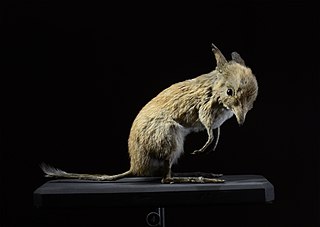
Chaeropus, known as the pig-footed bandicoots, is a genus of small marsupials that became extinct during the 20th century. They were the only members of the family Chaeropodidae in order Peramelemorphia, with unusually thin legs, yet were able to move rapidly. Two recognised species inhabited dense vegetation on the arid and semiarid plains of Australia. The genus' distribution range was later reduced to an inland desert region, where it was last recorded in the 1950s; it is now presumed extinct.

Macropus is a marsupial genus in the family Macropodidae. It has two extant species of large terrestrial kangaroos. The term is derived from the Ancient Greek μάκρος, makros "long" and πους, pous "foot". Thirteen known extinct species are recognised. The type species is the eastern grey kangaroo.
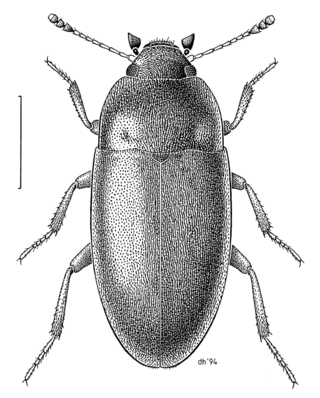
The family Archeocrypticidae is a small group of beetles with no vernacular common name, though recent authors have coined the name cryptic fungus beetles. Adults and larvae seems to be saprophagous and are often found in plant litter. Worldwide, about 10 genera and 50 species are found, most species are pantropical. Enneboeus caseyi has been recorded from the American South, Central America, and Mexico. About 20 species are found in Australia, in the genera Enneboeus,Australenneboeus and Gondwanenneboeus,Archeocrypticus,Falsoplatydema, Nothenneboeus, Sivacrypticus and Wattianus. They are largely absent from the Palearctic and Nearctic regions.

The yellow-spotted monitor, also known as the Argus monitor, is a monitor lizard found in northern and western regions of Australia and southern New Guinea.

The pygmy long-eared bat is a vesper bat, found in the north of the Australian continent. An insectivorous flying hunter, they are one of the tiniest mammals in Australia, weighing only a few grams and one or two inches long.

Saccolaimus is a genus of the family Emballonuridae, small insectivorous bats with distinctive sheathtails and pouches at the wrist.
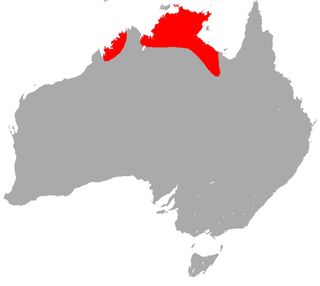
The northern leaf-nosed bat is a micro-bat of the family Hipposideridae, known as "leaf-nosed" bats. The species is endemic to northern regions of Australia. They are highly manoeuvrable in flight, and use echolocation to forage for insect prey.

Leucopatus is a genus of velvet worm in the family Peripatopsidae, containing a single species, the blind velvet worm. It is found in northeast Tasmania, Australia, and is ovoviviparous.
Eutrombicula is a genus of mites in the family Trombiculidae. The species of this genus are found throughout North America, and Australia.

Abispa is a genus of large Australasian potter wasps belonging to the subfamily Eumeninae. The genus was first described in 1838 by Thomas Livingstone Mitchell.

Nascio is a genus of Jewel Beetles in the beetle family Buprestidae. There are at least four described species in Nascio, found in Australasia.
The Australian Faunal Directory (AFD) is an online catalogue of taxonomic and biological information on all animal species known to occur within Australia. It is a database produced by the Department of Climate Change, Energy, the Environment and Water of the Government of Australia. By May 12, 2021, the Australian Faunal Directory had collected information about 126,442 species and subspecies. It includes the data from the discontinued Zoological Catalogue of Australia and is regularly updated. Started in the 1980s, its goal is compile a "list of all Australian fauna including terrestrial vertebrates, ants and marine fauna" and create an "Australian biotaxonomic information system".

Abispa splendida is a species of wasp in the Vespidae family.

Abispa laticincta is a species of wasp in the Vespidae family.

Polyzosteria is a genus of around sixteen species of cockroaches in the Blattidae family native to Australia. Some of these insects are attractively marked, such as Polyzosteria mitchelli. The type species of the genus is the Botany Bay cockroach, Polyzosteria limbata.
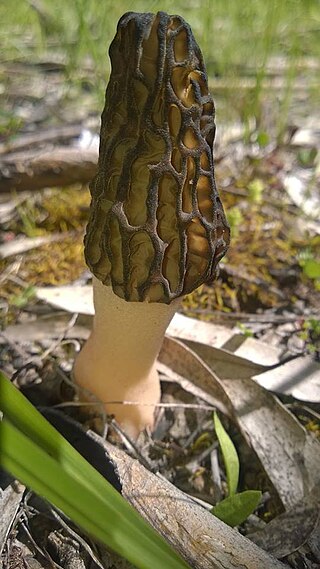
Morchella australiana is a species of ascomycete fungus in the family Morchellaceae. Described as new to science in 2014, it is found in New South Wales, South Australia, Tasmania and Victoria, Australia. The type locality was in the temperate Pilliga Scrub of northwestern New South Wales, west of the Great Dividing Range. Fruit bodies of the fungus resemble those of the European Morchella elata, but molecular and morphological analyses demonstrated that the Australian species represents a unique lineage.

Dicranolaius bellulus is a species of soft-winged flower beetle in the family Melyridae, found in Australia, in all mainland states and territories. It was first (partially) described in 1830 by Félix Édouard Guérin-Méneville as Malachius bellulus with the publication of illustrations. However, Guérin-Méneville completed the description with the publication of a text in 1838. Consequently, the Australian Faunal Directory considers the first valid publication to be that of Jean Baptiste Boisduval in 1835. Taxonomic reasons for the various synonyms are given in a 2017 paper by Liu, Slipinski and Pang.
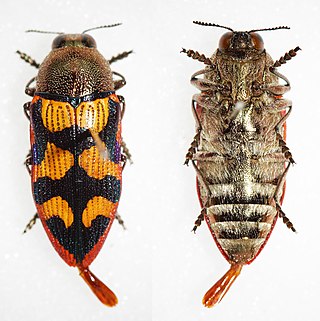
Castiarina simulata is a species of beetle in the jewel beetle family, Buprestidae, found in Western Australia, South Australia and Victoria.

















